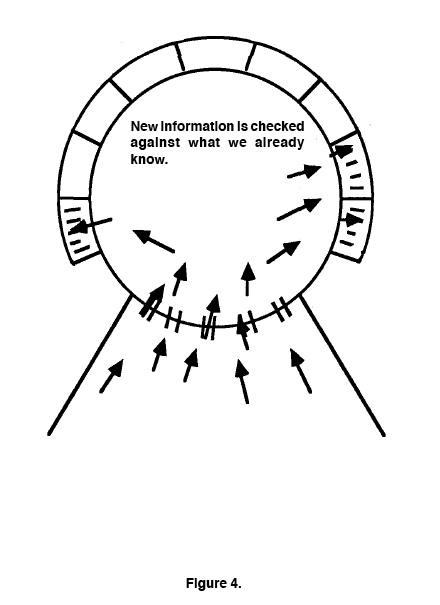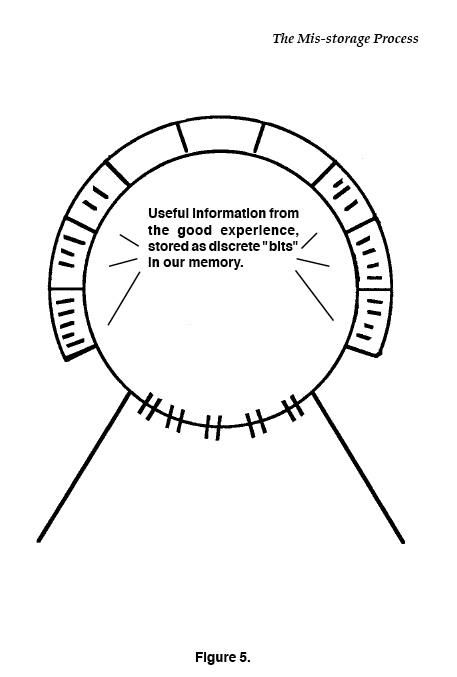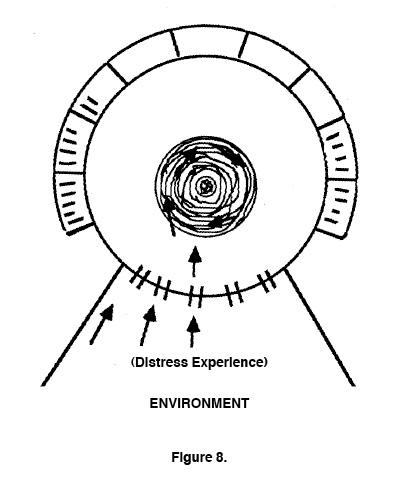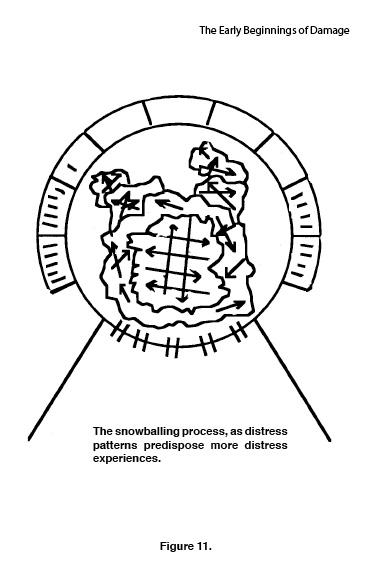Humans Acquire Distress Patterns From Being Hurt
The special human capacity for rational response can be interrupted or suspended by an experience of physical or emotional distress. When this occurs information input through the senses then stores as an unevaluated and rigid accumulation, exhibiting the characteristics of a very complete, literal recording of all aspects of the incident. Distress patterns may affect the person intermittently, or, if the restimulation of the pattern has reached a certain point, chronically (i.e., will "play" all the time).
Distress patterns tend to force their victim through a re-enactment of the original hurt that caused the pattern. Thus patterns are addictive in their actions. What are called "addictions" in ordinary language are the effects of patterns. Yielding to compelling feelings embodied in patterns is the necessary and sufficient explanation of addiction. All addictions, including chemical addictions, operate only through recorded distress patterns. Distress patterns tend to grow and even "snowball" through rehearsal/restimulation.
The Source of Damage
We get hurt.
Just that, we get hurt.
Very early in life the first time, and repeatedly after that, we meet experiences of distress. When we meet one-whether the distress is physical (pain, illness, unconsciousness, anaesthesia, sedation, acute discomfort, etc.) or whether it is emotional distress (loss, fright, frustration, ridicule, boredom, etc.)-a particular effect takes place.
While hurting, physically or emotionally, our flexible human intelligence stops functioning.
The ability that is the essence of our humanness, our ability to see things as they are exactly and to contrive new exact responses to all new situations, is slowed down or becomes inoperative.
This is a simple, profound and important statement. It is a long-unfaced key to much that has been confusing about a human being's activities. You will find that it sheds light into many dark puzzles about ourselves.
When I and my associates first realized, about two and a half years after we began the work that led to this descriptive model of a human, that we could actually generalize to this point, that we found no data that conflicted with this impression of a general principle, we were very excited.
We have remained excited, as this statement's validity and importance have become more and more apparent. Yet, curiously enough, once seen, this general principle turns out to be part of the intuitive store of knowledge of our population. It reveals itself in descriptive phrases with which we are all familiar and which we all use to describe the effects of a distress experience.
Do these phrases seem familiar to you?
- "I was scared out of my wits!"
- "She was out of her mind with pain."
- "He was so mad he couldn't hit the ground with his hat."
- "She seemed to be in a fog for months after her mother died."
- "You'd better take the rest of the day off. You're so upset, you'll only make mistakes, anyway."
Give your attention to any one of these familiar statements. (There are many more just as familiar.) Each is a remarkably accurate description of a particular case of the general phenomenon-we can't think intelligently while we are in distress.
This is a disadvantage, of course. We would much prefer to have "presence of mind" (note the intuitive accuracy of the familiar phrase) while distresses are occurring.
Temporary loss of intelligence is only the beginning of the mischief, however. Something even more serious and consequential ensues.
The Mis-storage Process
Though the "thinking machinery" is shut down and inoperative during the distress experience, the information input from all the environment which it usually handles suspends very little, if at all. Information continues to enter the distressed, non-thinking person in great volume through the senses of vision, sound, touch, etc.
This information input during a distress experience stores, or, more correctly, mis-stores, in a very different way from the usual information input that we take in during a non-distressing experience.
Information from a good experience becomes useful information which we can use to handle the next experience more "wisely."

(Incidentally, the usual information storage is done, apparently, in "discrete bits"; i.e., we can remember and use information from a good experience either piece by piece or all together, as we choose.)
 .
.
The mis-storage of the information received during a distress experience is very different. It can be described in several ways.
If we think of our flexible intelligence as if it were gear-and-cog computing machinery, then the information input during a distress experience acts as if it deposited onto this machinery when it was shut down, piled up on the gears and cogs in a certain area and jammed them.

When one comes upon this residue in a person's behavior and feelings later, the impression is very much that of a frozen, nonsensical rigidity. Unless the observer knows how this residue got there it seems to make no sense at all.
In another way, this mis-storage behaves as if it were a rigid scar on what used to be flexible surface.

Information from a distress experience is not available bit by bit, but only in one big tied-together chunk. If this information is recalled at all, it all comes together, unevaluated, not understood.
In yet another important way, the mis-stored information input from a distress experience behaves as if it were a recording, a very literal, detailed, complete recording of everything that went on during that distress experience.

It is as if the sights, the sounds, the tastes, the touches, the temperatures, the balances and all the rest of the information together with the feelings of distress and the inability to think were all recorded simultaneously on one ninety-channel record.
The First Bad Effect of Mis-storage
Most of us have assumed that we were "over" a distress experience, that soon after it had ended we were "back on our feet again." Actually, this should and could take place, and the discussion of how to get it to take place is the main purpose of this book.
Probably because of the way in which human cultures and civilizations have developed, this real recovery from the effects of distress experience rarely takes place.
Instead, the residue of information mis-storage left by the distress experience remains mis-stored. Two important effects result.
The first of these effects is quantitative. In ordinary language, we are not as intelligent as we were before the distress experience left this mis-storage upon us. Part of our originally vast, genius-sized intelligence is left tied down, inoperative.
It is not just that there is now a certain area of experience where we no longer think very intelligently. That is true; but there is also an overall lowering of our total capacity to think flexibly, to handle our environment well.
This quantitative effect will not be noticed by us when we are still young. Apparently we have so much more of the capacity available than we usually call upon that we don't miss the lost portion during our youth. This quantitative effect will be noticed later in life, however. As many distress experiences accumulate and are re-inforced by re-stimulation (which we will discuss later) the growing lack of capacity to think may be noticed.
We might call the noticing point "middle age," although it arrives in the teens for some and in very advanced years for others. Many persons seeking help describe this lack spontaneously in their initial interview.
"I'm losing my grip" is a favorite description. "Running out of slack" is another common one. "These last years seem to have taken all the starch out of me," said one person. "I'm not the man I used to be and I'm beginning to think I never was," said another. "I don't seem to have what it takes any more" is common.
These descriptions are quantitative in nature and express awareness of a loss of ability for coping with the environment. This first effect, the quantitative loss effect, will usually not be noticed in youth.
The Second Bad Result
The second kind of effect will be noticed while young, but not understood.
The second kind of effect can be examined by viewing the distress mis-storage as a recording. Carrying this distress-experience recording, we are now "booby-trapped."
When we are confronted by a new experience that is similar enough to the recorded distress experience we are compulsively forced to meet it with an attempted re-enactment of the old distress experience.
One might say that, "reminded too much of" the old distress experience, we are forced to behave as if we were some kind of walking "juke-box." In effect, the new experience "pushes the button." The recording of the old, miserable experience then rolls out as if from a rack onto a "turntable in our head." The recording now plays us!

The person now in the grip of this recording of an old distress experience says things that are not pertinent, does things that don't work, fails to cope with the situation, and endures terrible feelings that have nothing to do with the present. This is sub-human behavior, quite unlike the creative, capable behavior of a thinking person.
We are all familiar with these occurrences as we observe them in other people, though we have not understood them. We can almost (almost!) say that we have never had any trouble with another human being except for just this sort of occurrence; i.e., except for the irrational way people behave when they are upset.
Otherwise, we get along fine with everyone, don't we?
The "almost" above allows for the times when we become upset and we behave irrationally. We can accept the existence of such times logically, but we are not capable of observing them at the time.
The experience which "reminds us too much of" the old distress experience and thus triggers the distress recording into "taking over" may be itself a distress experience. It may contain occurrences intrinsically distressing to us. This may be one of the strong points of similarity to the old one. It does not, however, have to be intrinsically distressing to have this effect.
All that is necessary is that it be similar enough in enough ways, that it smell enough like the old one, have enough of the same voices, colors, characters in it. When this requirement is met, then distress feelings indistinguishable to the person feeling them from current ones are supplied by the re-stimulated recording. The present experience feels and affects us like a distress one, even though perfectly innocent in its actual content.
In the grip of the re-stimulated distress recording, the person talks foolishly, acts inaccurately and unsuccessfully, and feels terrible feelings that have no logical connection with what is actually going on.
The "Snowballing" of Distress
This distressed behavior is bad enough. It is, how-ever, not the last of the mischief. The "thinking machinery" is inoperative once again. Once again infor-mation is fed through the sense channels to an intelli-gence that isn't functioning.
The information input from this new experience is new. It cannot be evaluated, however, while the rational processes are interrupted. This information input also mis-stores in the same way as the original distress ex-perience.
The effect is as if more random, unevaluated debris clogs more areas of our thinking machinery. One might say that "more gears are jammed," or that "the booby trap acquires more triggers," or that "the ten-inch recording grows to a twelve-inch one."

The net effect is that each experience of being re-stimulated or "reminded too much of" in this way leaves the person predisposed to be upset more easily, by more things, more often, more deeply, and for longer periods of time.
The effect is a snowballing one. It is as if the hurt patterns were sticky surfaces which attract and add new sticky surfaces at a geometric rate.
The Early Beginnings of Damage
Each of us, of course, meets hurt experiences very early in his/her life. Our physical weakness, lack of experience and information and the resulting extreme dependence on others when we are very young leave us wide open to be hurt repeatedly in this period.
These early hurts may be inflicted by many things. Bumps and bruises and accidents and cold and hunger and frustration can all play their part.
In our civilization, however, the dominant source of hurts when we are very young is precisely the distress patterns of the adults around us. For an adult to behave irrationally is upsetting to a baby; and when that irrationality consists of or is accompanied by crossness, reproach, invalidation, ridicule, aloofness or violence as it usually is, the hurt is severe.
Perhaps you can imagine an infant playing happily with her mother. She is warm, happy, outgoing, loving towards her. The mother is warm, happy, outgoing, loving to her baby. The world is a wonderful place.
Then the phone rings and the mother goes to answer it. Baby waits for the wonderful play to resume. She has no way of knowing what signals come to her mother over the phone, nor of understanding their effect if she did know. So it can happen when the mother returns and baby stretches her arms to her warmly and lovingly, she is met with an expression of disgust and a loud, harsh voice saying "Don't bother me!" in tones of hate.
Sounds coming over the phone have triggered an old distress recording in the mother, which takes over and "plays" itself at the baby through her. The source of the recording has nothing to do with the baby or the mother's relation to her. Baby, however, is hurt, and a recording etches itself as she stops thinking and the experience mis-stores.
Whatever distress the experience contains will remain rigidly attached to the entire experience and to any experience which "reminds" the baby of it later. This rigid effect will vary greatly with each infant, depending on details and especially on what earlier distress patterns already exist to be re-stimulated by this one.
One infant in a situation like the above may be left with a fixed distrust of all other people. Another may be left with a rigid sense of his/her being a "bother."
In any case, the "tracks" of this kind of early experience will show, with great effect, among the rigidities of the adult into which the infant grows. The adult, in his/her first interview with a counselor, is likely to volunteer that he/she "is a nuisance," that he/she wants help to quit being "such a bother to everybody." A host of later distress and/or re-stimulation experiences will be related as indicating what a "bother" he/she is, but eventually, as his/her counseling progresses, the effect of the early experience will emerge as the significant "direction-fixer" it has been.
We are hurt early and often, primarily by the distress patterns of the adults in whose charge we are. These early hurts are re-stimulated and added to at an increasing rate, becoming chronic and "numb" (i.e., seeming to become calloused) in some areas, but always continuing to clog our thinking abilities at an increasing rate.

This is the bad side of "growing up." This process of "ossifying" our flexible intelligence has gone on relentlessly for all of us.
The Extent of the Adult's Loss
The degree to which this limiting process has gone on is something we have been slow to face. In the first years of our work, we did not suspect either how intelligent humans are to begin with or how severely that intelligence has been interfered with for any adult. We can only estimate now, but we can make an informed estimate.
We estimate that the successful adult in our present culture, the man or the woman whom everyone would agree is doing "just fine," is operating on about ten percent of his or her original resources of intelligence, ability to enjoy life and ability to enjoy other people.
The other ninety percent of her or his vast potential is covered over with rigid patterns of behavior and feeling, the mis-stored information residue of unevaluated experiences of distress.

Most of these patterns are latent, i.e., they behave as if they were recordings waiting in the rack. They inhibit the human's capacity and lower his/her potential, but they do not dominate his/her behavior nor his/her feeling except and until they are re-stimulated by particular circumstances in his/her environment. These recordings do not play until he/she is "reminded too much of" the distress experience.
It is easy to think of examples from your own experience. For many people, a "stage fright" recording only takes over when the particular conditions of the public appearance re-stimulate it. Most people do not go around "stage frightened" all the time. Many spouses only "go to pieces" a certain way when under the critical scrutiny of a parent-in-law. They do not feel nor act irritably defensive in that particular manner at other times.
How Distress Patterns Become Chronic
For all of us adults, however, a few distress patterns have been re-stimulated to the point of becoming chronic. These have become, in effect, recordings which play all of the time.
The chronic patterns can be described in various ways. It is as if the push button for these recordings was pushed so often it broke in the ON position. It is as if these recordings finally "built their own turntables" and play all the time. It is as if the person has made some kind of surrender to these particular patterns.
The chronic pattern is worn by the individual as if it were a portable prison cage. He/She remains rational, flexible, and intelligent only in ways that do not contradict the chronic pattern.

We view our own latent distress patterns as difficulties, as "problems," if we are aware of them at all. The chronic pattern will, on the other hand, be defended by the wearer as the "only way to be" if it is called in question. We defend these chronic behaviors and feelings if they are held up for discussion. We compulsively and unhappily regard them as our "personalities" or, at worst, "interesting idiosyncrasies."
Permissive counseling will not suffice to undo a chronic pattern, though it is usually quite sufficient for a latent one. Much more resource, time and ingenuity will go into unraveling a chronic pattern and freeing the wearer from it than are necessary for a latent one. The counselor needs to be equipped with a thorough understanding of the difference.
Chronic patterns become very "total" in their effect upon their victims. They are manifested in postures, repetitive cliches of speech, rigid rituals of behavior that are included in the responses to all situations. They include chronic emotional atittudes. These emotional attitudes will become etched upon a person's facial expression in the signs of grief, anxiety, etc., which most older adults wear whenever in "repose."
Yet chronic patterns arise and have their sources in exactly the same occurrences as the lighter or "latent" patterns. Each is the residue of unevaluated experiences of distress acting as compulsive recordings of behavior and feelings. The chronic recording simply plays all the time once it becomes re-stimulated past a critical point.